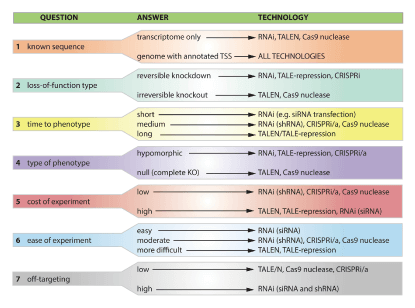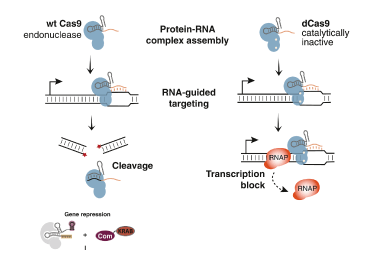The most common way of researching a gene’s function is by conducting a phenotypic analysis after decreasing or blocking the corresponding gene expression. RNAi is always the most common technologies used to reduce gene expression. However, the newly emerging technologies such as CRISPR-Cas9, have gradually begun to replace RNAi. One of the main reasons for this shift is that RNAi targets mature RNA while CRISPRi alters the gene expression on the transcriptional level. RNA is more unstable than DNA, leading to mix results when using RNAi. CRISPR-Cas9, on the other hand, is much more suitable for analyzing the specific function of non-coding RNA. Additionally, since CRISPR is near the transcriptional start site, off-target effects are much less than RNAi.
Guide for Choosing RNAi, TALEN and CRISPR

Operating Process of CRISPRi/a

Service Advantages of CRISPRi/a
Service Advantages of CRISPRi/a
- One-Stop Service
Synbio Technologies provides the overall scheme from the design, synthesis and vector construction of sgRNA, to the regulation and detection of the gene’s expression. - Patented Technology Platform
sgRNA Case Designer, which is under patent, can provide multi-species sequence designing scheme efficiently and accurately. - Syno® 2.0 gene Synthesis Platform
The platform has the capabilities to synthesize customized vector of sgRNA and Cas9, and realize the series assembly up to 8.
Reference
[1].Boettcher, et al., Choosing the Right Tool for the Job: RNAi, TALEN, or CRISPR. Molecular Cell, 2015. 58(4): p. 575.
[2].Qi, L.S., et al., Repurposing CRISPR as an RNA-Guided Platform for Sequence-Specific Control of Gene Expression. Cell, 2013. 152(5): p. 1173-1183.

